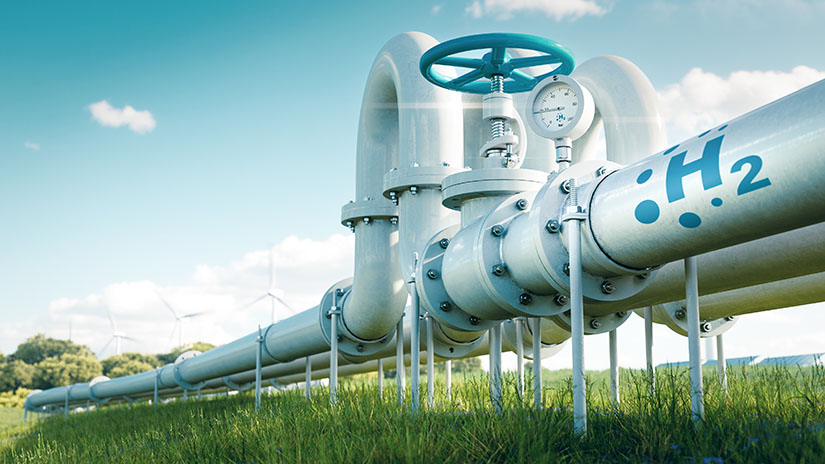Hydrogen Blending as a Pathway Toward U.S. Decarbonization

The U.S. natural gas infrastructure is expansive, providing service for 32% of the nation’s energy consumption in 2021. To reduce the emissions from natural gas service, blending hydrogen into natural gas pipelines could prove to be a promising, cost-effective pathway. It would not only use existing natural gas infrastructure but also serve key end users where electrification is uneconomic.
Hydrogen is an energy carrier that can be produced and consumed with nearly zero emissions in several key markets where natural gas is used today. Blending hydrogen into natural gas pipelines is just one of these markets, but numerous challenges and uncertainties complicate this approach.
A technical report co-authored by researchers at the National Renewable Energy Laboratory (NREL), Sandia National Laboratories, and Pacific Northwest National Laboratory reviewed the state of hydrogen blending technology to provide direction for future hydrogen blending research. The report, titled “Hydrogen Blending into Natural Gas Pipeline Infrastructure: Review of the State of Technology,” explores material, economic, and operational factors that must be considered, including summaries of studies that developed relevant mathematical models used to study how blending hydrogen impacts the operation of natural gas transmission and distribution infrastructure.
“The concept of blending hydrogen into natural gas pipelines is not new and has been around for decades, but there remain large knowledge gaps,” said Mark Chung, NREL's hydrogen systems analysis lead. “We hope this study serves as a useful reference for those considering blending demonstrations or future areas of related research.”
One of the primary challenges with hydrogen blending is hydrogen-induced cracking. Solid metals can be easily permeated by hydrogen because it is the smallest element in the universe. As hydrogen atoms are absorbed and diffused within pipeline steel, they can affect the material’s fatigue- and fracture-resistance properties. These impacts could render pipeline steels more susceptible to cracking.
The technical report discusses the research needed to combat this phenomenon. While there are design guidelines for assessing suitable operating pressures for common pipeline materials, more fatigue and fracture testing of vintage steels used in the U.S. natural gas pipeline system are needed to identify limiting behavior in hydrogen environments. Furthermore, the impact of hydrogen on different materials and equipment, such as plastic piping, compressors, valves, and on other non-pipeline equipment, such as storage facilities, also needs to be evaluated. For example, the presence of hydrogen in some geologic storage formations could stimulate and grow preexisting subsurface microorganisms such that the contained hydrogen is consumed to produce hydrogen contaminants. The effect of hydrogen on microorganisms in geologic storage facilities is not well studied but is essential to understanding how to ensure hydrogen-blending integrity. Through the DOE-funded SHASTA project (Subsurface Hydrogen Assessment, Storage, and Technology Acceleration), multiple national laboratories are working together to determine the viability, safety, and reliability of storing pure hydrogen or hydrogen–natural gas blends in subsurface environments.
Operational Considerations
Pipeline material degradation is not the only challenge hydrogen presents. The energy density of hydrogen also presents energy transmission challenges. At a fixed pressure drop along a length of pipeline, hydrogen’s lower energy per unit volume than natural gas reduces a pipeline’s capacity to transport energy and may not sufficiently service end-user energy demands. Increasing the flow rate of hydrogen-blended gas though pipelines could compensate for the reduced capacity, but the energy used for compression must also increase to compensate for increased pressure drop along the pipeline. Doing so may result in additional costs to the pipeline operator and, eventually, end users.
The technical report summarizes these operational considerations for economic assessment of hydrogen blending opportunities. The opportunity costs associated with the reduced energy transmission capacity of hydrogen blends should be factored in as well as steps needed to prepare pipeline networks and end-use applications for hydrogen blending.
Real-World Demonstrations
Another challenge for implementing hydrogen blend systems is the lack of hydrogen blending demonstrations and research. The few demonstrations around the world in recent years have proved that low hydrogen blends with natural gas are feasible, but these demonstrated scenarios were limited in end uses.
Small case studies are only the beginning. Further research is needed across the entire hydrogen and natural gas supply chain to fill current knowledge gaps and better inform policy and decision makers on future hydrogen blending projects. Projects are currently underway to demonstrate larger-scale pipeline systems with higher blends and pure streams of hydrogen.
The HyBlend™ initiative, which produced the technical report, was created by the U.S. Department of Energy’s Hydrogen and Fuel Cell Technologies Office to address technical barriers to blending hydrogen in natural gas pipelines. NREL leads a collaborative R&D project within HyBlend that includes three other national laboratories—Sandia National Laboratories, Pacific Northwest National Laboratory, and Argonne National Laboratory—and more than 30 partners from industry and academia. The report is informing the development of models and analytic tools to evaluate the technical requirements of blending hydrogen as part of the HyBlend initiative’s objectives, including an open-source natural gas pipeline upgrade tool for release in late 2023.
Learn more about NREL's hydrogen and fuel cell research.
Last Updated May 28, 2025
